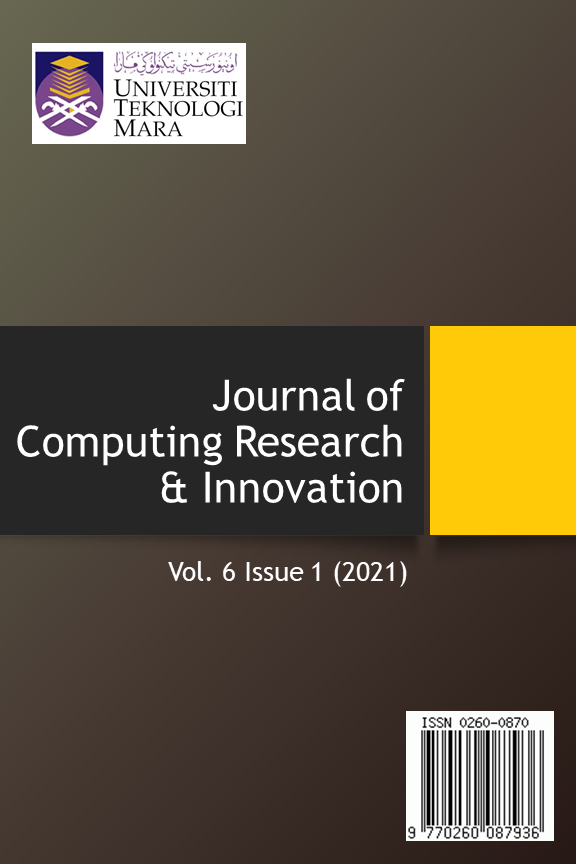Multi Selection Control Algorithm in Examination Invigilation Management System(ExIMS) for Exchanging Invigilation Duties Among Invigilators at UiTM Pulau Pinang Branch
DOI:
https://doi.org/10.24191/jcrinn.v6i1.172Keywords:
invigilation, multi-selection, TAM, Technology Acceptance Model (TAM), Multi Selection Control AlgorithmAbstract
Invigilation of the examination is one of the important roles and tasks of lecturers appointed as invigilators or proctors. Based on the past semi-annually reports of examination post-mortems meeting, less than 10% of the invigilators were unhappy with the examination duties that have been assigned or appointed to them. The examination committee members who are responsible in the process of assigning the invigilation duties to each invigilator had given a lot of effort and spent a few weeks to ensure that everybody is happy with the invigilation duties assigned to them. Nevertheless, despite the excellent planning of invigilation duties assignment, it cannot make everybody satisfied. Thus, a web-based application system named Examination Invigilation Management Systems (ExIMS) has been developed using the System Development Life Cycle (SDLC) waterfall model methodology to meet the need of invigilation duties exchanged among invigilators or applicants. This system has been developed to control and cross check the request of invigilation duties exchanged using the algorithm named multi selection control. The algorithm could avoid any conflicts or anomalies that could happen after the exchange of duty has been made. The process of duty exchange is examined and verified automatically by the system. The system provides a platform for users or invigilators to give their views or opinions on the invigilation duties and system features or performance through the online survey. The survey uses the TAM method concentrating on the perceived-ease-of-use (PEOU) component. Based on the survey, 95% respondents reported that they were satisfied with the platform for duty exchange among invigilators. The users can easily and flexibly select the new duties, which will be automatically and mutually swapped among invigilators. ExIMS has solved the problem of unsatisfaction of invigilation duties and increased the happiness index among invigilators during the examination period.
Downloads
References
Ahmed, A., Sajid, A., Ali, M., & Bukhari, A. H. S. (2011). Particle Swarm Optimization Based Hyper-Heuristic For Tackling Real World Examinations Scheduling Problem. Australian Journal of Basic and Applied Sciences, 5, 1406–1413.
Avinash, B.R., Vijaykumar, D.V., Rajeev, M.P., Parkar, V. V. (2015) “Automated Examination Support Systemâ€. International Journal of Current Engineering and Technology, Vol 5, Number 1, February 2015, E-ISSN 2277 – 4106, P-ISSN 2347 – 5161.
Carter, M. W., & Laporte, G. (1997). Recent developments in practical course timetabling. In International Conference on the Practice and Theory of Automated Timetabling (pp. 3–19). Springer.
Dharshini, S.P., Sudha, M.S. (2018). “Exam Cell Automation System,†International Journal of Engineering Science and Computing (IJESC), Vol 7, Number 3.
Di Gaspero, L., Schaerf, A., Cadoli, M., Slany, W., & Falaschi, M. (2003). Local Search Techniques for Scheduling Problems: Algorithms and Software Tool. Forum.
Existek. (2020). “SDLC Models Guideâ€, Retrieved December 04, 2020, from https://existek.com/blog/sdlc-models/
Sagir, M., & Ozturk, Z. K. (2010). Exam scheduling: Mathematical modeling and parameter estimation with the Analytic Network Process approach. Mathematical and Computer Modelling, 52(5), 930–941.
HEA. (2019). “Minute Meeting of Examination Committeeâ€, Department of Academic Affairs, UiTM Cawangan Pulau Pinang, Number 2/2019.
Kahar, M. N. M., & Kendall, G. (2010). The examination timetabling problem at Universiti Malaysia Pahang: Comparison of a constructive heuristic with an existing software solution. European Journal of Operational Research, 207(2), 557–565.
Mat Yusof, K. (2020), “Invigilator System for UMP Examination Problem Based on Faculty of Computer System & Software Engineering (FSKKP)â€, Retrieved December 01, 2020, from DOI/Official URL: http://iportal.ump.edu.my/lib/item?id=chamo:92281&theme=UMP2
Mohamed, A. S., Mushi, A. R., & Mujuni, E. (2013). An Examination Scheduling Algorithm Using Graph Coloring–the case of Sokoine University of Agriculture.
Othman, J., Abdul Wahab, N., Kadar, R., Warris, S.N. (2017). Assigning Examination Invigilator's Schedule Problem: An Approach of Programming Techniques Using Simple Sequential Assignment. Journal of Computing Research & Innovation (JCRINN) Vol 2, Number 1, pp 1-13.
Othman, J., Kadar, R., Abdul Wahab, N., Warris, S.N. (2018). Examination Management Systems: A Survey of User Acceptance Level in UiTM Cawangan Pulau Pinang. Journal of Computing Research & Innovation (JCRINN) Vol 3, Number 1, pp 46-54.
Quality. (2010). Quality Manual of UiTM Cawangan Pulau Pinang, ISO 9001:2008.
Sarin, S. C., Wang, Y., & Varadarajan, A. (2010). A university-timetabling problem and its solution using Benders‘ partitioning - a case study. Journal of Scheduling, 13(2), 131–141.
UiTM (2001), Nilai dan Etika Pensyarah, Universiti Teknologi MARA.
UiTM. (2016). Examination Procedures Manual, Academic Assessment Division of UiTM.
Wikipedia (2020). “Technology acceptance model (TAM)â€, Retrieved December 05, 2020 from https://en.wikipedia.org/wiki/Technology_acceptance_model
Winston, W., R. (1970). Managing the Development of Large Software Systems, Proceedings, IEEE WESCON, August 1970, pages 1-9.
Wyer, M., Eisenbach, S. (2001). “Lexis Exam Invigilation Systemâ€, Retrieved December 01, 2020 from https://www.usenix.org/legacy/publications/library/proceedings/lisa2001/tech/full_papers/wyer/wyer_html/index.html
Downloads
Published
How to Cite
Issue
Section
License
Copyright (c) 2021 Jamal bin Othman, Sharifah Sarimah Syed Abdullah, Norshuhada Samsudin, Wan Nur Shaziayani Wan Mohd Rosly

This work is licensed under a Creative Commons Attribution-ShareAlike 4.0 International License.


